Know your Citrix Workspace app
This section helps you become familiar with Citrix Workspace app. This page includes follwing sections:
Introduction
The latest user interface (UI) of Citrix Workspace app enhances user experience by simplifying visual complexity, making key functions easily accessible, and fine-tuning Workspace app functionality as needed. This app experience is available only for customers on cloud stores. After successful authentication to Citrix Workspace app, the welcome screen appears for the first time. You can click Continue to enter the app.

Once you enter the app, Personalize your home screen appears for the first time. You can add apps and desktops to favorites for quick access using this screen. To add apps and desktops to favorites, select the apps and desktops as required and click Add to favorites on the Personalize your home screen or click Skip to add it later. This screen is visible only if you have more than 20 apps or desktops assigned to you.
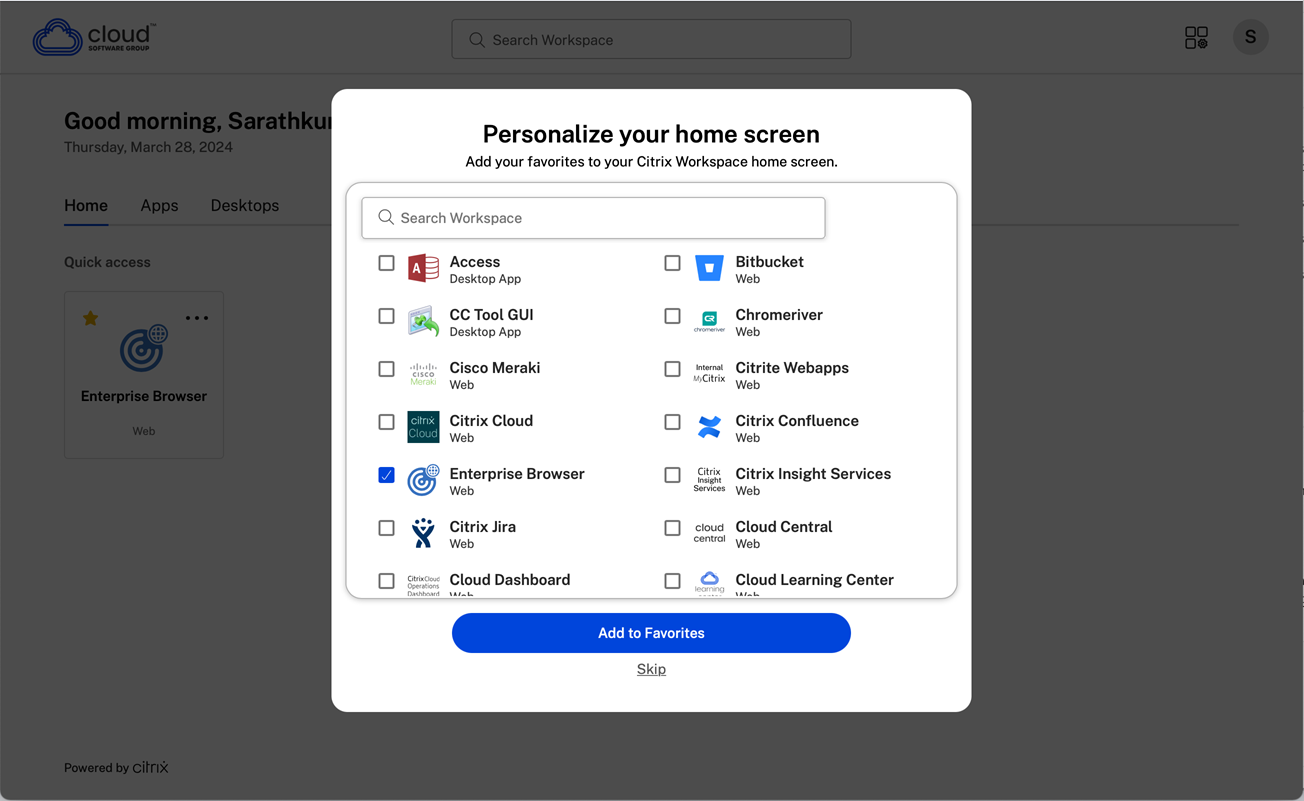
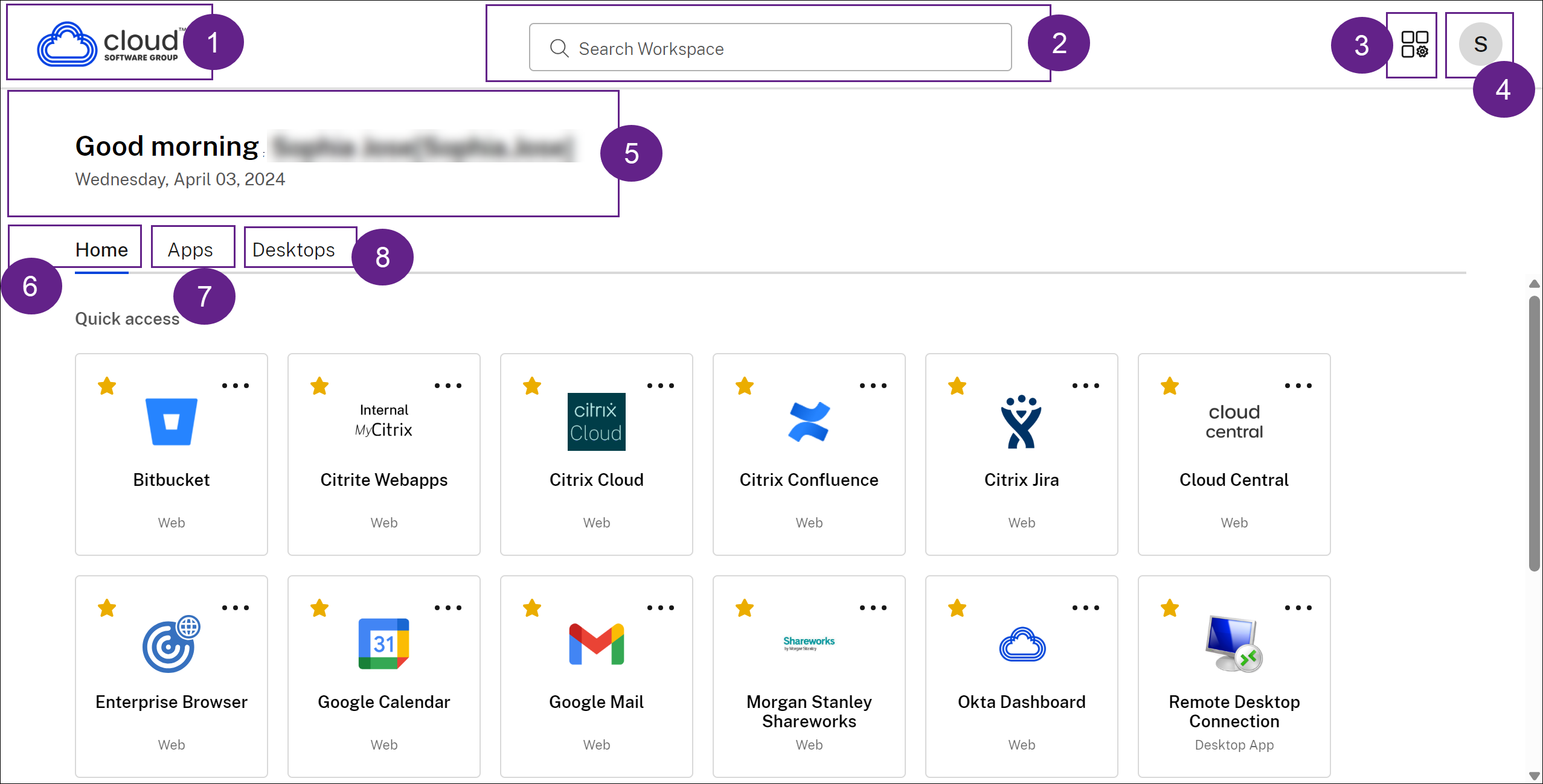
The Citrix Workspace UI contains the following elements:
| Field | Description |
|---|---|
| 1 - Organization’s logo | It’s placed on the top-left corner of the screen. Click this logo to navigate to the home page. |
| 2 - Search Workspace | Type the search criteria in the text box. The results are populated as you type a search criteria. You can also find the results for apps or desktops for a fuzzy search with closely matching text and misspelled search terms. |
| 3 - Activity Manager icon | Click this icon to manage the running sessions. For apps, you have options to Log out or Disconnect from the activity manager. For desktops, you have power management options such as Disconnect, Log out, Shutdown, Restart, and Force quit. The Activity manager might not be visible to you based on the preference set by your admin. |
| 4 - Account icon | Click this icon to view the Account settings, Refresh, About Citrix Workspace, Accounts and the Log out options. |
| 5 - Greetings message | The greetings according to the time of the day, along with your name, appear. Your name is displayed as it exists in your administrator’s records. |
| 6 - Home | Displays all favorites and five recent apps and desktops. The apps and desktops are arranged alphabetically, with favorites at first and then recents. |
| 7 - Apps | Displays all apps that are provided by your admin. The apps are arranged alphabetically, with favorites at first. The apps are categorized so you can find them quickly and easy. |
| 8 - Desktops | Displays all desktops that are provided by your admin. The desktops are arranged alphabetically, with favorites at first. |
On each app and desktop tile, you have the star icon to mark it as a favorite. Also, you have a three-dot menu (…) on each app and desktop tile to open, add or remove favorites, and view details. Additionally, you have the restart option for desktops.
Home
The Home tab displays all favorites and five recent apps and desktops for quick access to them. You can access the Home by clicking the Home tab or by clicking the Organization logo at the upper-left corner.
Note
The Home tab might not be visible to you based on the preference set by your admin.

Apps
The Apps tab displays a list of all the apps that are assigned to you. You can access the Apps by clicking the Apps tab. By default, all the apps are arranged alphabetically, with favorites listed first.
The apps are grouped into different categories and sub-categories, as customized by your admin. You can click on a category to view the apps belonging to that category. You can find additional categories by clicking More. The apps that are not categorized are grouped under Others.
The apps with the lock icon are mandatory apps, and you can’t remove those apps from the favorites.
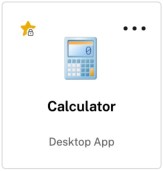
The categories displayed in the preceding image are for representational purposes.

Note
If there are no apps assigned to you, then the Apps tab isn’t visible. If there are no categories configured by your admin, then Categories aren’t visible in the Apps tab.
Desktops
The Desktops tab displays a list of all the desktops that are assigned to you. You can access the desktop by clicking the Desktops tab. By default, all the desktops are arranged alphabetically, with favorites listed first.
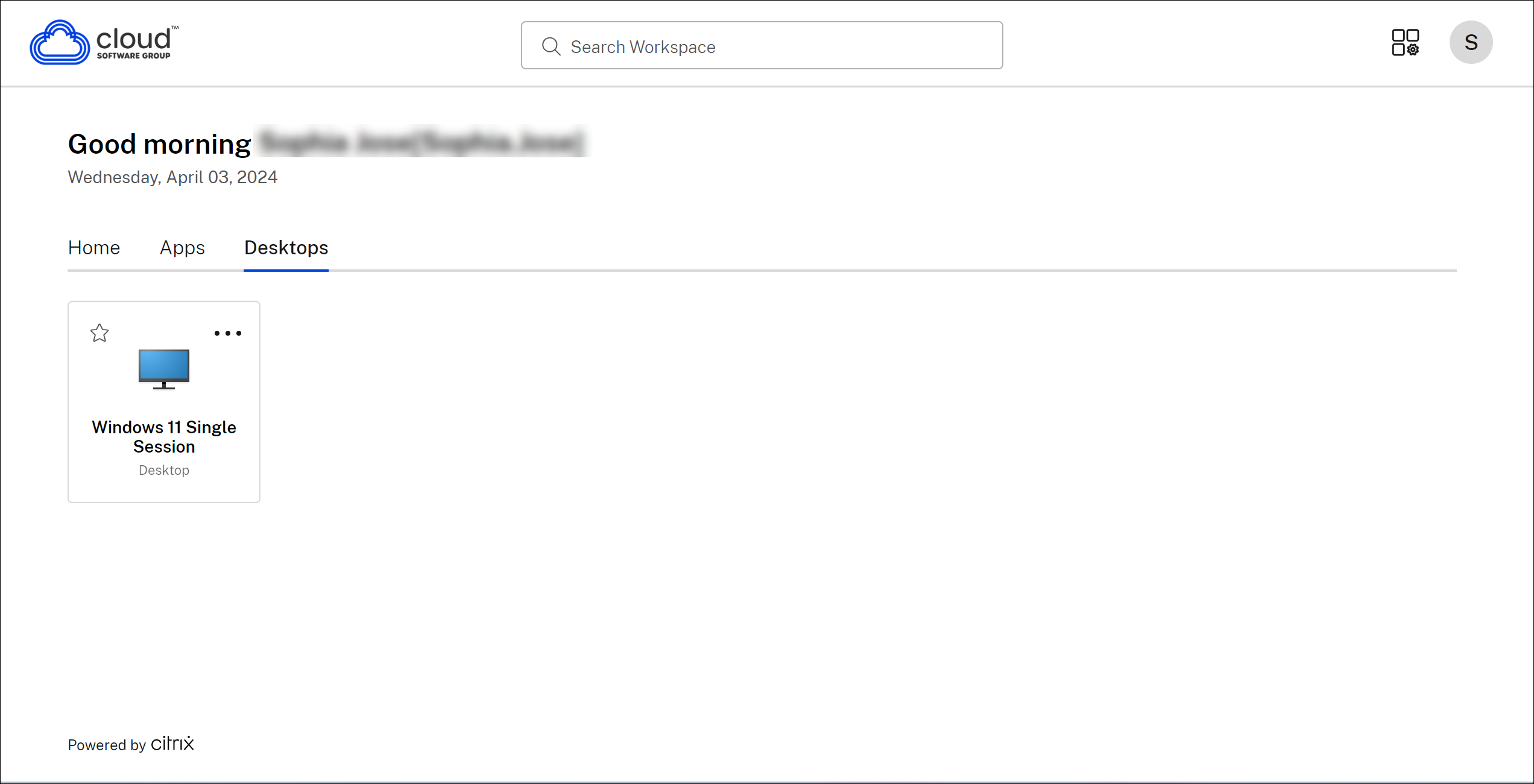
Simple view UI experience
If you have fewer than 20 resources, by default, you land on the screen with a simple view UI that doesn’t have any tabs or categories. All the apps and desktops appear on the same page. On this screen, your favorites show up first, followed by all the other apps in alphabetical order. All the apps have a star icon that you can use to favorite or unfavorite them. You experience this simple view of the Workspace app, depending on the number of apps you have and preferences set by your admin.
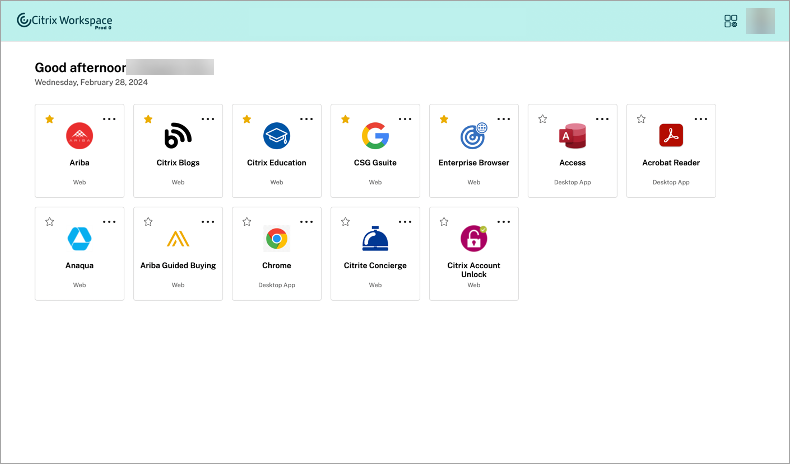
Search Workspace
The Search Workspace bar displays the faster results for quick access of apps and desktops. It allows you to do a quick and intuitive search within the Workspace app. When you click the Search Workspace bar, the five most recently used apps or desktops are displayed by default and as you type in the names of apps, desktops, more results appear. You can also search the names of the categories to find them quickly. The search result lists Favorites always at the top.
Searches are enabled with spell check, display results for fuzzy search with closely matching text or misspelled search terms, and display auto-complete results along with actual results and suggestions. It can display results of admin created categories in the Apps tab.

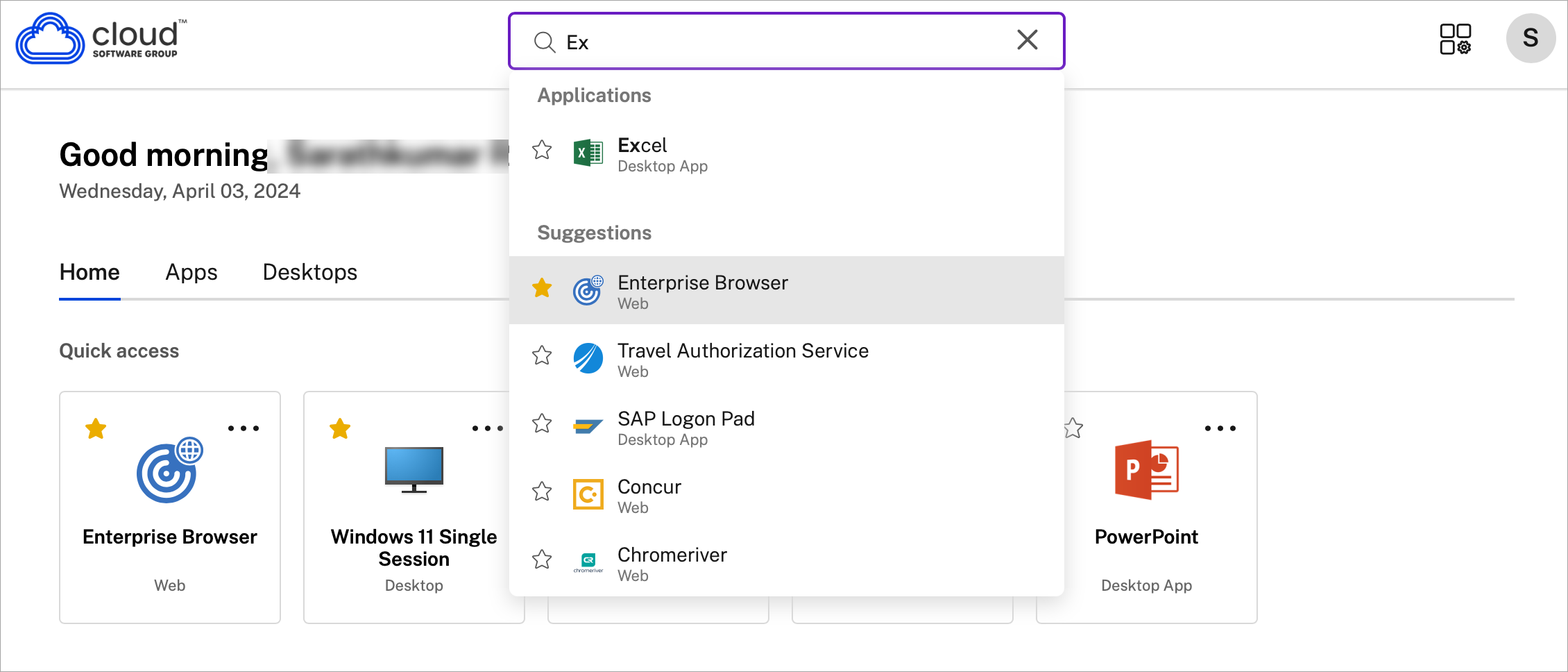
Activity Manager
Activity Manager helps you effectively manage your resources. You can seamlessly interact with their sessions, ending or disconnecting sessions that are no longer required, freeing up resources, and optimizing performance on the go.
The Activity Manager panel displays a consolidated list of apps and desktops that are active not only on the current device but also on any remote device that has active sessions. You can view this list by clicking the Activity Manager icon located next to the profile icon on desktop and at the bottom of your screen on mobile devices.
Contact your administrator to configure Activity Manager.
Using Activity Manager
Active apps and desktops are grouped as follows in Activity Manager:
- A list of apps and desktops that are active on the current device is grouped under On this device.
- A list of apps and desktops that are active on other devices are grouped under Running Remotely.

You can perform the following actions on an app or desktop by clicking the respective ellipsis(…) button.
- Disconnect: The remote session is disconnected, but the apps and desktops are active in the background.
- Log out: Logs out from the current session. All the apps in the sessions are closed, and any unsaved files are lost.
- Shut Down: Closes your disconnected desktops.
- Force Quit: Forcefully powers off your desktop in case of a technical issue.
- Restart: Shut down your desktop and start it again.
Disconnected apps and desktops
Activity Manager enables you to view and take actions on apps and desktops that are running in disconnected mode, locally or remotely. Sessions can be managed from mobile or desktop devices, enabling you to take action on the go. Taking action on disconnected sessions, such as logging out or shutting down, promotes optimized use of resources and reduces energy consumption.
![]()
- The disconnected apps and desktops are displayed on the Activity Manager panel and are indicated by a disconnected icon.
- The disconnected apps are grouped under the respective sessions, and the sessions are indicated by a disconnected icon.
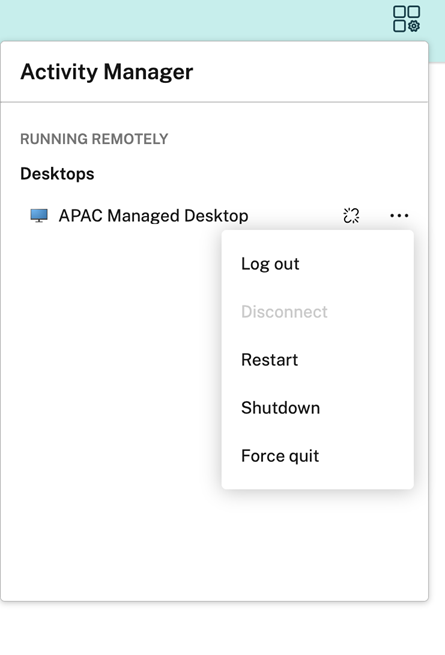
You can take the following actions on your disconnected desktops by clicking the ellipses button:
- Log out: use this to log out from your disconnected desktop. All the apps in the session are closed, and any unsaved files are lost.
- Shut Down: use this option to close your disconnected desktops.
- Power off: use this option to forcefully power off your disconnected desktops in case of a technical issue.
- Restart: use this option to shutdown and start the disconnected desktop again.
The behavior of disconnected sessions on Activity Manager differs as follows:
- If you are signed into Citrix workspace through a browser, and disconnect a local session, the session is first displayed under On this device. However, once you close and reopen Activity Manager, the disconnected session is moved under Running Remotely.
- If you are signed into Citrix Workspace app through a native device, and disconnect a local session, the disconnected session disappears from the list. However, once you close and reopen Activity Manager again, the disconnected session is moved under Running Remotely.